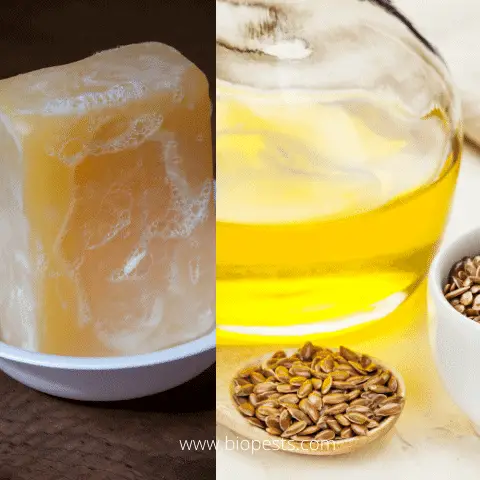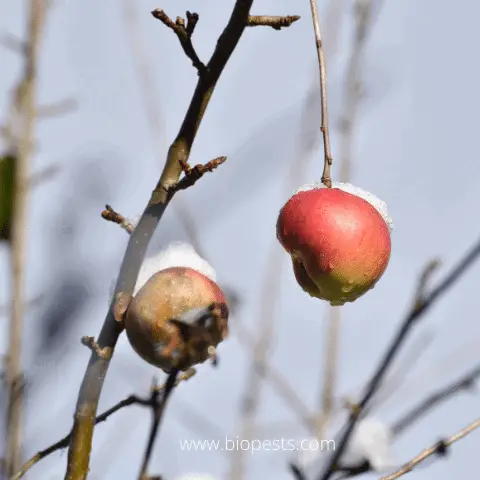If you have fruit trees in your garden you have surely heard of dormant oil, also known as horticultural oil.
Dormant oil is an essential element for the treatment and prevention of parasites that could harm your trees. But if you are like me, and you care about your health and that of your garden, you have surely questioned:
Is Dormant Oil Organic?
Although Dormant oil is allowed in organic farming, most of the products that we find on the market are petroleum-based products. The oil is cleansed of its most toxic substances through a distillation process. The result is a mineral oil with a specific viscosity that makes it very effective in killing pests, and at the same time has low toxicity for humans and plants.
The oil is usually combined with some type of emulsifying agent so that it can be mixed with water and used as a spray.
Unfortunately, conventional dormant oil has the disadvantage of being slightly toxic on plants at the beginning of their vegetative awakening, as it could damage the leaves and buds. For this reason, it is used at the end of winter, when the temperatures are still low and the buds of the trees are not yet fully developed.
Luckily, dormant oils were further refined to produce a lighter version that could be applied all year round, without harming the foliage and other beneficial insects. The term “dormant oil” nowadays is used to refer to the application time, which is usually the dormant season, rather than the type of oil.
Moreover, there are products based on vegetable oils, such as flaxseed oil or soybean oil. These oils are excellent substitutes for dormant oil and can be used all year round. I will refer to them later on.
Is Dormant Oil safe?
Although Dormant oil or Horticultural oil is labeled as a pesticide, its residue evaporates and dissipates quickly from the plant, meaning that it has a very low toxicity for humans and pets.
Nevertheless, when using the product, take the appropriate precautions. Wear protective gear before each application and store the product in a safe place, out of the reach of children.
It is important to read the label carefully and strictly comply with the prescribed methods of use; the recommended dosages and the waiting period.
By “waiting period” we mean the wait time between a pesticide application and when a crop can be harvested. Generally for dormant oil there are about 20 days of waiting time. However, it is important to check according to the product label.
Why is it so important to spray your trees with dormant oil?

Those who own fruit trees know that at the end of winter, when everything still seems to be in hibernation, there are parasites who instead work full-time to take advantage of those days and lay their eggs.
The best time to apply dormant oil is when the days are still cold with temperatures just above freezing and the buds of your trees are just beginning to awake.
The insecticidal action of dormant oil is mechanical, meaning that it is not absorbed by the foliar apparatus of the plant. Once the oily solution is sprayed on all the branches of a fruit tree or bush, the oil covers the surface of the insect’s outer shell, preventing any oxygen from passing through. As a result, the insect and its eggs die of asphyxiation in a very short time.
Dormant oil is very effective against the following pests:
- adelgids
- aphids
- caterpillar eggs
- leafhoppers
- mealybug
- mites
- scale
- spider mites
- thrips
- whiteflies
Using dormant oil on fruit trees does not completely eliminate the problem with these pests, but it is the best way to decimate the majority of the population. Later in the season it is possible to make other applications to completely eradicate the presence of certain pests.
The trees and plants that benefit the most from dormant oil are:
- Apples
- plums
- quinces
- pears
- gooseberries
- currant bushes.
Dormant oil could harm plants susceptible to oil sprays. It is advisable not to spray on trees such as cedars, maples, spruce, and junipers.
How To Apply Dormant Oil
Dormant oil should be used on late winter days, when the buds on the trees have not yet started to swell. Before any application, check the weather conditions. Outdoor temperature must be at least 4°C (40F) and remain so for at least 24 hours, without any chances of rain nor wind.
If you need to spray a small tree, a simple spray bottle with a diluted solution of water and dormant oil is enough. In the case of two or more trees, a backpack sprayer may be more comfortable. Start spraying from the highest branches to the lowest ones, covering the whole tree including the trunk. Pay particular attention to spray inside all the cracks in the bark because it is there that insects usually overwinter and love to hide.
If you are using petrol-based dormant oil, cover the nearby flowers because the product could damage them.
If you are using lighter vegetable-based dormant oils make sure you don’t spray them during the hottest hours of the day. Remember that plants can’t handle oil as they would likely burn in the hot sun.
The residual effect on the plants is almost absent. This means that only the insects on which the product is sprayed directly will die, while those who do not come in contact with the oil will survive undisturbed.
Do’s and Don’ts when applying Dormant oil
When applying dormant oil, follow these simple rules:
- Don’t apply dormant oil when the outside temperature is extremely high: as I mentioned before, plants are very susceptible to horticultural oil damage.
- Don’t apply dormant oil when it is freezing outside: the outside temperature should be above the zero (40F or 4°C) so that the emulsion will hold together and the coverage will be even.
- Don’t apply dormant oil when it is raining nor in very humid conditions: an application in rainy conditions makes it completely useless.
- Don’t apply during the fall: it increases the risk for winter damage and the heavy rains might dissolve the product quickly.
- Don’t apply if you used pesticides containing sulfur in the past 30 days. Sulfur and horticultural oil is a toxic combination for plants.
- Don’t apply on plants known to be sensitive to horticultural oil, such as cedars, maples, spruce, and junipers. Usually, on the label of the package, there is a list of plants where this product can be used.
Is There An Alternative To Dormant Oil?
Dormant oil has been used for its insecticidal action for a very long time. Although derived from petroleum, it is a permitted product in organic farming, less harmful than many other pesticides. Unfortunately, it has the disadvantage of being phytotoxic on plants at the beginning of their vegetative awakening. If we wanted to use it in spring, for example, it could ruin the young shoots.
Furthermore, if used on trees in full bloom it could harm bees and other beneficial insects.
Therefore, the reason in organic farming, conventional dormant oil is used in winter. As a valid alternative, farmers have recently found a dormant oil substitute to use throughout the year. In place of petroleum-based dormant oil, there are other types of oils that are less toxic to plants and to beneficial insects, such as flaxseed, cottonseed, and soybean oils.
Flaxseed Oil As An Organic Alternative To Dormant Oil

If you want to switch to a completely organic product, it is possible to create your own natural insecticide by using flaxseed oil together with insecticidal soap.
Flaxseed oil also has the advantage of being protective against viral diseases and various types of fungi. Aphids are the main carrier of plant viruses, and this oil has proven efficacy as a protector against virus transmission as well as aphid control.
Comparing it to other vegetable oils, flaxseed oil is much easier to use since it remains mixed in water for a longer time than vegetable oils, with larger particles that are difficult to emulsify.
You can make your own spray by mixing 4 tablespoons of flaxseed oil with 4 tablespoons of insecticidal soap in about 10 liters of water.
Attention: Don’t spray on to plants that are under stress (dehydrated or near wilting). If in doubt, water the plant before spraying. If it has wilted, water the plant and wait for it to recover before spraying.
Flaxseed oil is not tolerated by some plants, especially ferns and black walnut trees or other plants of the genus Juglans. It should not be sprayed on plants with blue foliage since their color is a result of the waxy coating on the leaves or needles. The oil would remove it.
When spraying the oil, make sure to cover both sides of the leaves. Most insects hide under the leaves or along the stems. Remember that the oil must target the parasite to eliminate it.
Some of the links above are affiliate links, meaning at no additional cost to you, I will earn a commission if you click through and make a purchase.

